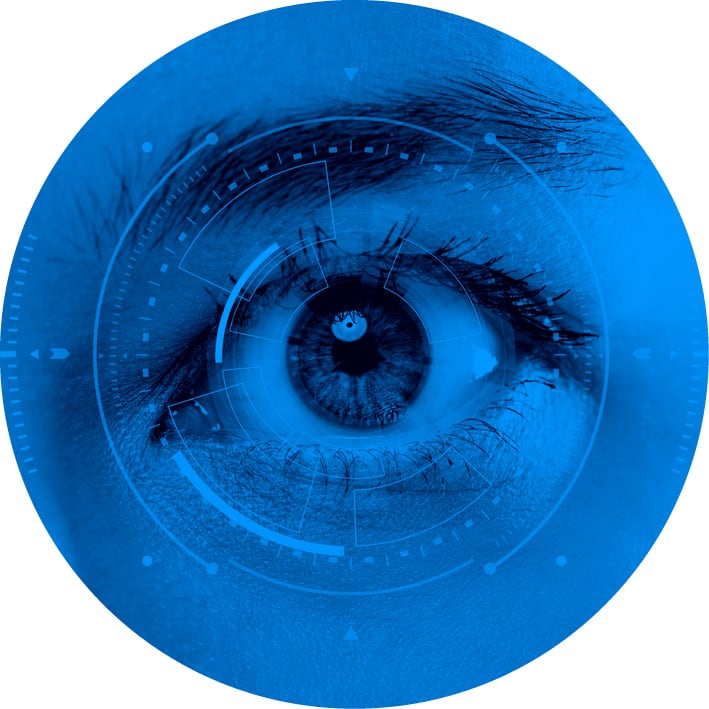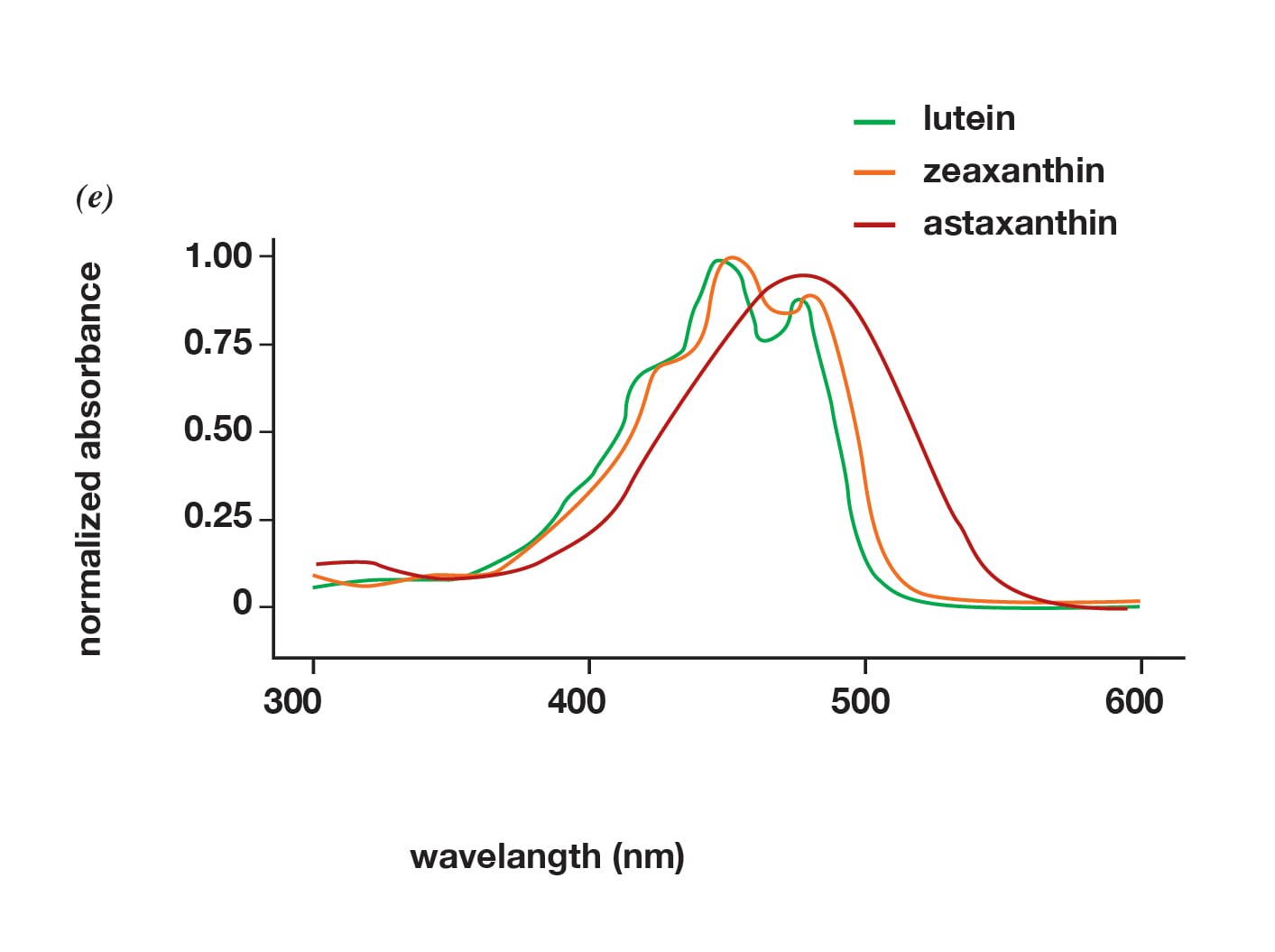Our eyes are under attack
By the time we reach middle age, our eyes have spent more than one billion seconds bombarded by sunlight, artificial light, computer/smart device screens, pollution, allergens and foreign bodies. Then there’s the insults from strain, fatigue, chronic sleep deficit, nutritional deficiencies and disease.
Yet one of the most damaging assaults to our eyes derives from oxidative stress. This includes damage to cellular DNA and cellular bodies caused by oxygen-based molecules known as reactive oxygen species (ROS) and called “free radicals” when specifically involving oxygen.

The production of free radicals is triggered by light, pollution and endogenous chemical reactions. This occurs when the antioxidant defense system can’t keep up with the oxidative conditions that lead to the production of free radicals.
The eye is particularly vulnerable to oxidative stress due to its exposure to light, its rich content of mitochondria and the high metabolic rate of photoreceptors(1). Antioxidants are a first-line defense against the attack on our eyes.

Among the antioxidant ingredients that are especially effective for protecting our eyes from the damages caused by direct insult as well as oxidative stress are those called carotenoids. These are a lipid-soluble class of organic compounds that act as pigments (ranging from yellow to red) in the cells of plants and animals. Carotenoids are produced by plants, algae and some fungi and bacteria.
The human eye is an incredibly complex organ comprised of multiple tissue types, layers and parts. All must work perfectly in synch and be constantly maintained. But the problem with any complex system is that there are far more things that can break down or go wrong.
Eagle eyes
The most advanced eyes in the animal kingdom are avian eyes, especially those of the eagle. They can perform outstanding feats of sight and acuity, absorbing light from across a spectrum that includes light invisible to the human eye. The eagle’s eye is the same size as a human eye yet some eight times more capable. Able to see at night, an eagle can spot its prey from a height of more than two miles (3.2 km).(2) Yet soaring so high, the eagle’s eyes are constantly bombarded by high-altitude light that has less atmospheric filtration. This includes highly damaging blue light, ultraviolet light and other solar radiation.
Another advantage the eagle eye has over the human eye is an unusual combination of carotenoids, specifically astaxanthin. Human eyes rely more on zeaxanthin and lutein.(3) Astaxanthin is a powerful antioxidant that offers unique protection for the eye in combination with the other carotenoids, providing stronger light absorption, across broader wavelengths, than the other carotenoids. In fact, a number of studies support astaxanthin’s ability to protect the retinas from light-induced damage and suggest a carotenoid complex that includes astaxanthin could protect the eyes from damage across the entire solar spectrum. (4)
Astaxanthin’s importance to eye health
The importance of astaxanthin to eye health cannot be overstated. Astaxanthin is one of the more efficient antioxidant compounds. It intercepts the oxygen radicals known as singlet oxygen molecules and converts them into heat energy. It even works synergistically with other vision health-supporting carotenoids, such as lutein and zeaxanthin.(5)

Astaxanthin has been shown to help trigger natural defense proteins that support other antioxidant compounds and aid in detoxification. It attenuates molecules that signal inflammatory triggers, to act as an anti-inflammatory agent, and it increases ocular blood flow velocity, allowing the blood to reoxygenate the tissues of the retina and eyeball and clear out toxins and waste more efficiently.
Astaxanthin is unique in its ability to curtail some of the attacks age visits upon vision. In a Japanese study of 35 patients undergoing cataract surgery, two weeks of astaxanthin intake at 6mg per day boosted superoxide scavenging activity while suppressing production of cell-damaging compounds called hydroperoxides in the aqueous humor of the eye. These results suggest that astaxanthin can inhibit the development or onset of multiple oxidative stress-related diseases such as those described above.
Studies in patients suffering from age-related macular degeneration (AMD) reveal that the vascular layers of the eye, which are thickest at the retina and fovea, are decreased. Clinical studies showed that taking astaxanthin helped improve circulation in the capillaries of these vascular layers of the eyes and so could potentially stave off or slow the course of such vision-destroying diseases of the eye.(6)
Results of a 2017 animal study conducted by an international team of scientists revealed that oral astaxanthin at 6mg per day, and compared to either 6-10mg lutein or an extract of whole bilberry at 120mg daily, confers a protective effect on UV-induced photokeratitis — essentially, light-burn of the eyes. The effect was ascribed not only to astaxanthin’s antioxidative ability but its anti-inflammatory action and protective ability to keep cells from self-destructing.
Specifically noted was astaxanthin’s protection of tissues in the corneal epithelium: Following exposure to UV light, the integrity and thickness of the aforementioned tissues suffered significantly less damage than in the controls. An earlier study, in 2010, showed promise for glaucoma symptoms as well. In this study, astaxanthin supplementation exhibited a suppressive effect on retinal injury from elevated intraocular pressure.
Blue light: An emerging threat to eye health
Astaxanthin’s ability to benefit eye and vision health beyond its antioxidation capacities is far-reaching. Eye fatigue in modern times has become epidemic due to video display terminal (VDT) syndrome, a term used to describe the daily screen exposure load of between four and seven hours(7) that severely exacerbates the symptoms of eye fatigue. It directly impacts performance of the ciliary bodies in the eye that control lens refraction. The symptoms of eye fatigue can last as long, or longer, than the actual time spent under the strain of the VDT (computer and smart device screens).(8)
Blue light is the visible light ranging from 380 to 500 nm and is now considered an emerging threat to eye health. Approximately one-third of all visible light, including sunlight, is composed of blue light. But display screens of computers, electronic notebooks, smartphones and other digital devices emit significant amounts of blue light.
Excessive exposure to blue light can cause eye fatigue, pain, blurred vision, dryness and retinal damage. Asthenopia, the technical term for eye fatigue, advances throughout the day, with vision performance decreasing gradually from morning through until nighttime.
The cornea and lens of the eye are effective at blocking much of the damaging ultraviolet (UV) light, but nearly all visible blue light passes through the cornea and lens where it is picked up by the retina. But astaxanthin works especially well at absorbing blue light radiation, which falls between 400 and 495 nanometers — roughly the same light as radiated by VDTs.
In a recent randomized, double-blind placebo-controlled study where the experimental group received just 5mg astaxanthin for four weeks, the subjects reported that their overall eye fatigue symptoms had improved by some 54% compared to the placebo group. Astaxanthin also has been shown to help boost acuity of vision. It functions in the eye not only as a blue- blocker but also focuses visible spectrum, bringing sharper focus and detail differentiation to sight.(9,10,)

Innovative microencapsulation technology and superior bioavailability
Recognizing the superior abilities and benefits for eye and vision health of oral astaxanthin, either in supplement form or incorporated into certain foods and beverages such as bars or shots, Algatechnologies, Ltd. (AlgaTech) developed a formulation of algal astaxanthin — AstaPure EyeQ — with improved bioavailability.

AstaPure EyeQ is a powder formulation derived from Haematococcus pluvialis microalgae, the richest known source of natural astaxanthin. Algatech’s proprietary technology mimics the microalgae habitat and natural biological processes. The microalgae are cultivated organically and exposed to the harsh desert climate, which stimulates the microalgae to produce high levels of active compounds. It is a non-GMO, clean-label, sustainable ingredient.
AstaPure EyeQ is produced using natural food-grade materials, without polysorbate, micro encapsulated with whey proteins. The production process is made through a proprietary emulsion technology, encapsulated with natural agents, providing increased bioavailability. It has improved gastrointestinal tract permeability, and therefore assumed to have better bioavailability in the retina as well.
A clinical study conducted in 2018 by Algatech and led by Rafael Bitzur, PhD, former Secretary of the Israeli Society for the Treatment and Prevention of Atherosclerosis at the Lipids Clinic, Sheba Medical Center, Israel, demonstrates that AstaPure EyeQ delivers a two-fold increase in bioavailability over standard astaxanthin supplements.
A follow-on preclinical study, by Tatsuya Sugawara, PhD, of the Graduate School of Agriculture, Kyoto University, Japan, shows that AstaPure EyeQ reaches the plasma and crosses both the blood-brain and the blood-retina barriers, hence reaches the brain and eyes.
AstaPure EyeQ astaxanthin allows formulators to create and market natural, highly bioavailable products for eyes and cognitive health as well as brain health, that will help them differentiate themselves in the better-for-you marketplace. It has no flavor or aroma, and is thus suitable for health beverages, premixes, drinks, shots or dispenser caps. Or, it can be easily incorporated into supplements from softgels to gummies and other chewables, or functional foods, such as bars.
Vision and eye health product developers will want to make use of the optimal form of astaxanthin and craft products that bridge the full spectrum of absorption of carotenoids. AstaPure EyeQ with its superior bioavailability, can be an important addition to formulations developed for protecting eyes from constant environmental attack.
COME AND MEET ALGATECH @SSW, BOOTH #5311, LAS VEGAS 15-19 OCTOBER 2019
References
(1) Journal of Biological Chemistry January 17, 2003
278, 1932-1935. (http://www.jbc.org/content/278/3/1932.long).
“How Does The Eye Breathe? Evidence for neuroglobin-mediated oxygen supply in the mammalian retina” Marc Schmidt et alia
(2) National Eagle Center (www.nationaleaglecenter.org); Grambo, Rebecca L. (14 December 2003). Eagles. Voyageur Press. ISBN 978-0-89658-363-4.
(3) “Lutein and Zeaxanthin Isomers in Eye Health and Disease;” Annual Review of Nutrition 2016 Jul 17; 36: 571–602.
(4) Advances in Biochemical Engineering/ Biotechnology. 2015;148:449-67.
“Carotenoids of biotechnological importance.” Sandmann, G.
(5) “BioAstin Technical Bulletin #062”; R. Todd Lorenz, Ph.D.; October, 2000
(6) “Influence of astaxanthin, zeaxanthin and lutein on DNA damage and repair in UVA-irradiated cells;”
Journal of Photochemistry and Photobiology; M. Santocono, 2006 Dec 1;85(3):205-15.
(7) “Computer and visual display terminals (VDT) vision syndrome (CVDTS)”
Medical journal, Armed Forces India; J.K.S. Parihar. 2016 Jul; 72(3): 270–276.
(8) “The influences of smartphone use on the status of the tear film and ocular surface;” Choi JH
Public Library of Science One; 2018 Oct 31;13(10)
(9) Piermarocchiet al., 2012. Carotenoids in Age-related Maculopathy Italian Study (CARMIS): two-year results of a randomized study. European Journal of Ophthalmology, 2012 Mar-Apr;22(2):216-25.
(10) Kajita M, Tsukahara H, Kato M. “The effects of a dietary supplement containing astaxanthin on the accommodation function of the eye in middle-aged and older people.” Medical Consultations and New Remedies 2009;46(3):89-93. [Full Text]





